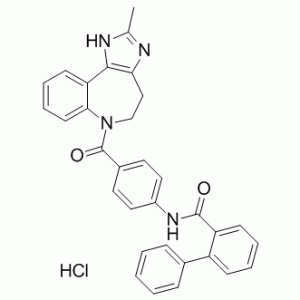Conivaptan HCl (YM 087)
This product is for research use only, not for human use. We do not sell to patients.

For small sizes, please check our retail website as below: www.invivochem.com
| Size | Price | Stock |
|---|---|---|
| 250mg | $650 | Check With Us |
| 500mg | $990 | Check With Us |
| 1g | $1485 | Check With Us |
Cat #: V1484 CAS #: 168626-94-6 Purity ≥ 98%
Description: Conivaptan HCl (formerly known as YM-087; YM087; YM 087, trade name Vaprisol), the hydrochloride salt of Conivaptan, is an orally bioavailable and non-peptide antagonist of vasopressin V1A and V2 receptors with anti-hypernatremic activity.
Top Publications Citing Invivochem Products
Publications Citing InvivoChem Products
Product Promise

- Physicochemical and Storage Information
- Protocol
- Related Biological Data
- Stock Solution Preparation
- Quality Control Documentation
| Molecular Weight (MW) | 535.04 |
|---|---|
| Molecular Formula | C32H26N4O2.HCl |
| CAS No. | 168626-94-6 |
| Storage | -20℃ for 3 years in powder formr |
| -80℃ for 2 years in solvent | |
| Solubility In Vitro | DMSO: 107 mg/mL (200 mM)r |
| Water: <1 mg/mLr | |
| Ethanol: 7 mg/mL (13.1 mM) | |
| Synonyms | YM-087 HCl; Conivaptan; Conivaptan; YM 087; YM087; Vaprisol |
| Protocol | In Vitro | Conivaptan (0.03, 0.1 and 0.3 mg/kg, i.v.) dose-dependently increases urine volume and reduces urine osmolality in both myocardial infarction and sham-operated rats. Conivaptan (0.3 mg/kg i.v.) significantly reduces right ventricular systolic pressure, left ventricular end-diastolic pressure, lung/body weight and right atrial pressure in myocardial infarction rats. Conivaptan (0.3 mg/kg i.v.) significantly increases dP/dt(max)/left ventricular pressure in myocardial infarction rats |
|---|
These protocols are for reference only. InvivoChem does not
independently validate these methods.
| Solvent volume to be added | Mass (the weight of a compound) | |||
|---|---|---|---|---|
| Mother liquor concentration | 1mg | 5mg | 10mg | 20mg |
| 1mM | 1.8690 mL | 9.3451 mL | 18.6902 mL | 37.3804 mL |
| 5mM | 0.3738 mL | 1.8690 mL | 3.7380 mL | 7.4761 mL |
| 10mM | 0.1869 mL | 0.9345 mL | 1.8690 mL | 3.7380 mL |
| 20mM | 0.0935 mL | 0.4673 mL | 0.9345 mL | 1.8690 mL |
The molarity calculator equation
Mass(g) = Concentration(mol/L) × Volume(L) × Molecular Weight(g/mol)
Mass
=
Concentration
×
Volume
×
Molecular Weight*
The dilution calculator equation
Concentration(start)
×
Volume(start)
=
Concentration(final)
×
Volume(final)
This equation is commonly abbreviated as: C1 V1 = C2 V2
Concentration(start)
C1
×
Volume(start)
V1
=
Concentration(final)
C2
×
Volume(final)
V2
Step One: Enter information below
Dosage mg/kg
Average weight of animals g
Dosing volume per animal µL
Number of animals
Step Two: Enter the in vivo formulation
%DMSO
+
%
+
%Tween 80
+
%ddH2O
Calculation Results:
Working concentration:
mg/ml;
Method for preparing DMSO master liquid:
mg
drug pre-dissolved in
µL
DMSO(Master liquid concentration
mg/mL)
,Please contact us first if the concentration exceeds the DMSO solubility of the batch of drug.
Method for preparing in vivo formulation:
Take
µL
DMSO master liquid, next add
µL
PEG300, mix and clarify, next add
µL
Tween 80,mix and clarify, next add
µL
ddH2O,mix and clarify.
Note:
- (1) Please be sure that the solution is clear before the addition of next solvent. Dissolution methods like vortex, ultrasound or warming and heat may be used to aid dissolving.
- (2) Be sure to add the solvent(s) in order.




































